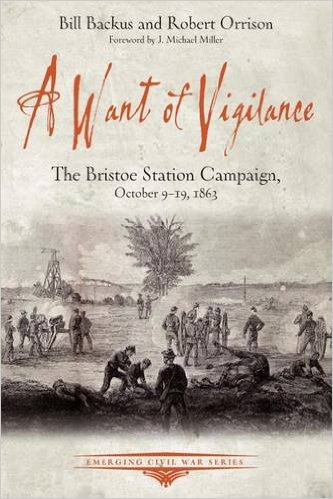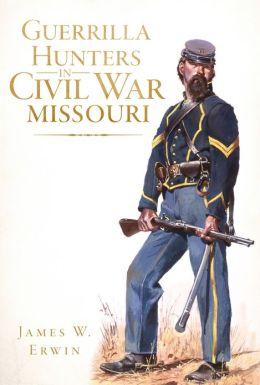A Want of Vigilance: The Bristoe Station Campaign by Bill Backus and Robert Orrison. Foreword by J. Michael Miller. Savas Beatie, 2015. Paper, ISBN: 978-1611213003. $14.95.
 For the average American, traditional accounts of the final two years of the Civil War follow a well-worn path: one that begins with the Gettysburg Campaign, fast forwards to the Overland Campaign ten months later, and eventually ends at Petersburg and Appomattox in the spring of 1865. The yawning gap in time between Gettysburg and the Battle of the Wilderness often imparts the notion that the Union Army of the Potomac and the Confederate Army of Northern Virginia sat around for almost a year licking their wounds before reengaging.
For the average American, traditional accounts of the final two years of the Civil War follow a well-worn path: one that begins with the Gettysburg Campaign, fast forwards to the Overland Campaign ten months later, and eventually ends at Petersburg and Appomattox in the spring of 1865. The yawning gap in time between Gettysburg and the Battle of the Wilderness often imparts the notion that the Union Army of the Potomac and the Confederate Army of Northern Virginia sat around for almost a year licking their wounds before reengaging.
In A Want of Vigilance: The Bristoe Station Campaign, Bill Backus and Robert Orrison insist that nothing could be further from the truth. From a strategic point of view, they insist that Robert E. Lee, despite suffering horrific losses in Pennsylvania during the summer of 1863, continued to press the initiative well into the fall of that year—momentum that he and his army never completely regained after Bristoe Station.
Backus and Orrison are trained historic preservationists with an appreciation and passion for Civil War history. While both have worked as curators and interpreters at state and national historic sites in and around Virginia, Orrison was instrumental in the development and preservation of a portion of the original
Bristoe battlefield. The authors contend that the public has forgotten the Bristoe Station Campaign in part because it failed to produce a massive, bloody engagement like Gettysburg or Antietam.
Lee’s strategy was to outflank the Union army by using Confederate cavalry to screen the infantry’s movements, thus bringing the fight to Union Gen. George Meade on Confederate terms. Unfortunately for Lee, while J.E.B. Stuart’s rebel cavalry successfully screened the infantry’s movements, the Richmond press continuously undermined the secrecy of the mission by printing news stories about the army’s whereabouts. To make matters worse, Lee’s supply wagons failed to keep pace with the infantry, slowing the army’s movements to a crawl and further undermining efforts to move swiftly and secretly.
The authors note that while Lee and Meade both struggled at times with subordinate commanders, Lee’s command structure during the campaign was decidedly worse. “Stonewall” Jackson was dead, and Gen. James Longstreet, arguably Lee’s most trusted corps commander at the time, had shuttled most of his corps south to bolster the fighting strength of the Confederate Army of Tennessee. Confederate commanders such as Henry Heth, A.P. Hill, and Richard Ewell simply could not fill the void left by Jackson and Longstreet. Still, despite major blunders on the part of several of Lee’s subordinate generals, the authors contend that the Confederate cavalry and infantry fought well. On the other hand, despite being constantly—and unfairly, the authors suggest—hassled by officials in Washington, D.C., George Meade and the federal army proved that they were up to the task, successfully countering Lee’s every move.
Checking in at around 150 pages, A Want of Vigilance is a fun little book to read. The authors devote separate chapters to the cavalry engagements at Brandy Station and Sulphur Springs, the Battle of Auburn, the main contest at Bristoe Station, and the fight at Buckland Mills. Each chapter features a combination of historical narrative mixed with modern tourist information—complete with GPS coordinates, state and county road designations, and special warnings about entering private property (most acreage along the campaign’s trail remains in private hands). The book includes Civil War era photographs of important people and places, maps of Confederate and Union troop movements, and modern photographs depicting the landscape as it appears today.
The book lacks a bibliography and an index. A bibliography is probably not necessary, since this title targets a more popular audience. An index, on the other hand, would assist readers in locating specific people, places, or events within the narrative.
Five of the six appendices included at the end of the book are essentially mini-essays detailing a handful of specific events, some controversial, that occurred during the campaign.
For academic purists and readers who prefer well-documented narratives complete with citations, A Want of Vigilance may fall short. But for Civil War enthusiasts, reenactors, battlefield tourists, and those who simply enjoy a good story, the book delivers favorably—if not admirably. Orrison and Backus have produced a readable and entertaining look into one of the war’s lesser known campaigns.
Tommy Brown is a Ph.D. student in history at Auburn University.
